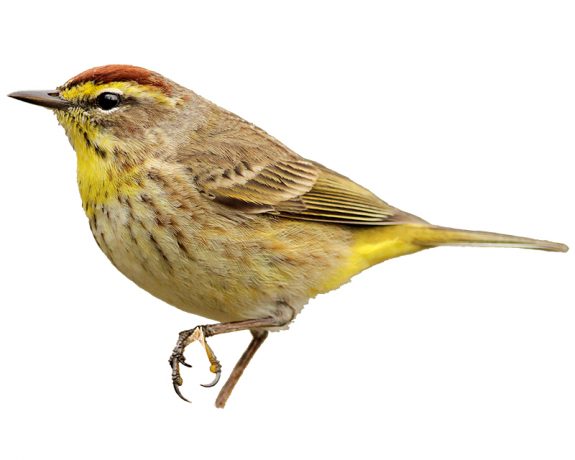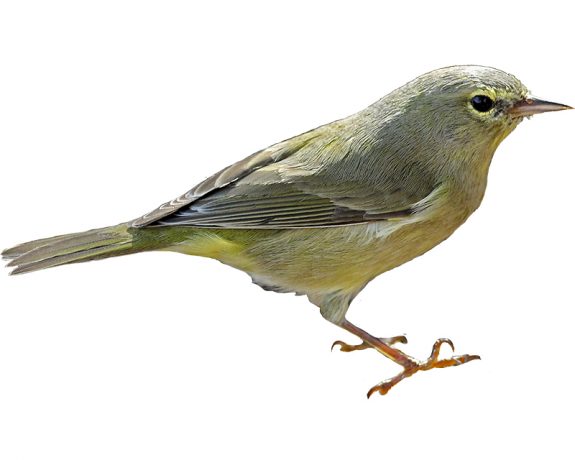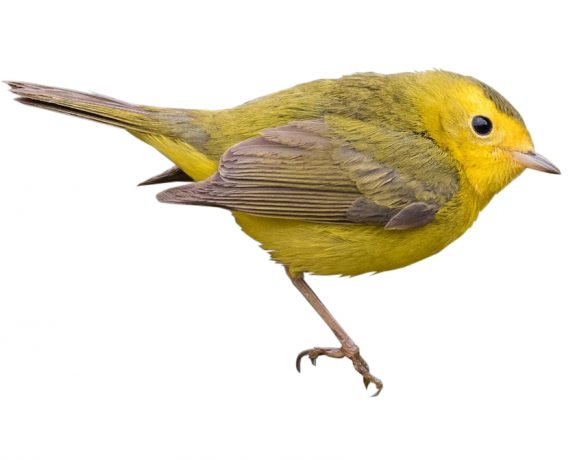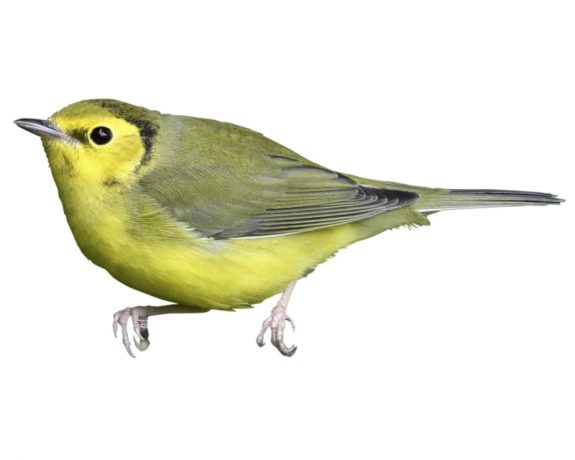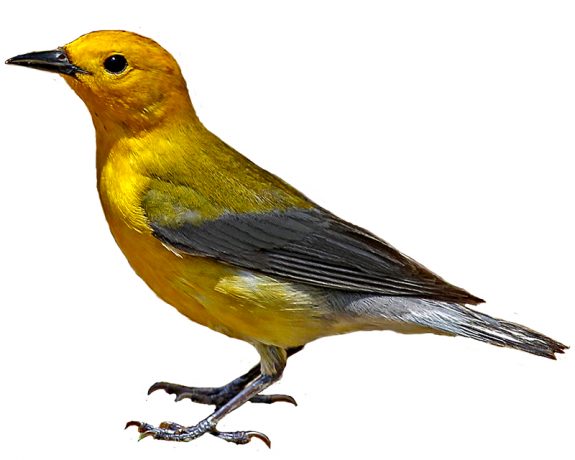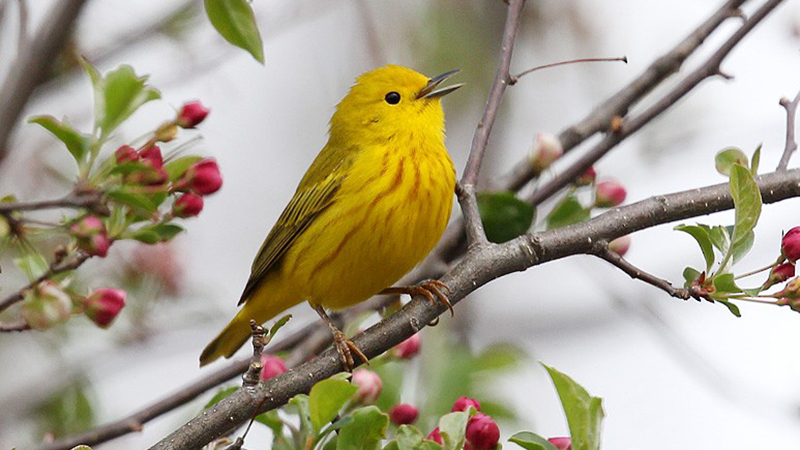Yellow Warbler Sample Lesson
In this slide, males are on the left, and females are on the right. Notice that the male has reddish streaks on the chest. Females can have some of that, but usually, they’re pretty plain yellow. Immatures are similar to the adult female, but just a little paler and duller.
Yellow Warbler breeds in wet, deciduous thickets, especially in willows. It’s also found in shrubby areas and old fields. In southern Florida and farther south, it can be found in mangroves. In addition to the migratory form of the yellow warbler that breeds all over North America, there’s several other resident forms in Mexico, Central America, and the Caribbean. Males in those populations have chestnut caps, or even an entirely red head. They’re pretty cool.
Chestnut streaks on the chest of male warblers is variable. And it’s less distinct in the fall. So expect to see some variation. The yellow warbler’s song is a series of clear whistled notes. The most common is a rapid musical “Sweet-sweet-sweet, I’m a sweet”. Let’s listen to that. (Yellow Warbler Singing) Can you hear how the mnemonic catches the change in rhythm of that, where it speeds up a little bit at the end, “I’m a sweet”? Yellow Warbler catches insects by gleaning, fly-catching and hovering.
Streaks on the females can be pretty variable too. So be ready for a lot of variation from completely yellow to heavily streaked. First fall birds are usually pale with very few streaks. And both the first year male and first year female look pretty much the same. Young birds can be very pale yellow. In fact, some of these guys look almost more brown than yellow. Sometimes we see rather patchy yellow on birds. This particular individual is a golden yellow warbler, that’s resident in the Caribbean. But we also can see similar young birds in other parts of their range too.
So what do I see when I see a yellow warbler? Well, first, they’re all yellow. They have yellow everywhere. All over the body and head, and even in the wings and tail. And really, no one part of the body outshines any other. There’s not real contrast here. The red streaks and the bright yellow chest of the spring male is a real giveaway.
But I always notice the big dark eye in that plain face in all plumages. And the yellow in the tail is diagnostic. So, what can you confuse it with? Well, the Palm Warbler is the only other warbler with red streaks on the chest, but it has a rusty cap and a dark eye stripe. The eastern form of this can be really yellow, though.
Orange-crowned Warbler has a dark eye line and pale eye crescents. It doesn’t have any yellow on the edge of the wing feathers, and it doesn’t have tail spots. The western form of this can be especially bright yellow. Prothonotary Warbler is another bright yellow warbler with a beady black eye and an all yellow face. But it has dark wings, it’s white under the tail, and has large white tail spots, not yellow.
Female and immature Yellow Warblers can be easily confused with female and immature Hooded and Wilson’s warblers. They all have plain yellow faces, and entirely yellow underparts. But neither the Hooded nor the Wilson’s has yellow edging to the wing feathers, or yellow tail spots. In fact, the Hooded Warbler has white tail spots. Those yellow tail spots are sometimes hard to see, but they’re present in all the plumages, and they really let you know you have a Yellow Warbler.End of transcript
Visual Keys to ID
- Setophaga petechia
- Setophaga petechia
Compare with Similar Species
These are the species commonly confused with the Yellow Warbler:
- Palm Warbler
- Orange-crowned Warbler
- Wilson’s Warbler female
- Hooded Warbler female
- Prothonotary Warbler
See more images with the All About Birds Species Comparison Tool
As Seen and Heard in the Field
Practice for the Field
Make Warbler ID a Snap
For each species, you will practice identification with our SnapID tool. Custom-developed by Bird Academy, SnapID lets you practice on photos of birds in all different positions and lighting conditions, because you almost never get a perfect profile view of a bird when you really need it.
SnapIDs are designed as a fun way to practice ID. You can replay each SnapID as many times as you want. Thanks to our bank of images for each species, you’ll get fresh pairings on each round. Your winning streaks are not permanently recorded. Once you’ve built up a reliable winning streak, you’ll know that you are ready to go find warblers in the field.
SnapID: Choose the Yellow Warbler
This is a sample lesson from Be a Better Birder: Warbler Identification. In this self-paced online course you’ll get comprehensive coverage of the 51 warbler species found in the U.S. and Canada as well as identification strategies and quizzes to help you along the way.
Photo credits
Yellow Warbler male: Kevin J. McGowan
Yellow Warbler female: Kevin J. McGowan
Palm Warbler: Kevin J. McGowan
Orange-crowned Warbler: Kevin J. McGowan
Wilson’s Warbler female: Ian Routeley/ML29261821
Hooded Warbler Female: Kevin J. McGowan
Yellow Warbler: Deborah Kral/M27659871
Video credits
Yellow Warbler, Timothy Barksdale/Macaulay Library 404381
Yellow Warbler, Michael J. Andersen/ Macaulay Library 125226


